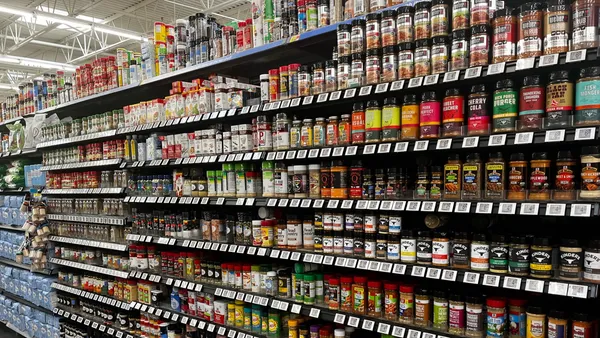Dive Brief:
- Shelf management practices may be more important than ever as more than half of shoppers (55%) say their purchasing decisions are made in-store, most often by looking through the section for the best price (22%), according to a new report by Acosta, a leading full-service sales and marketing agency. The top categories for in-store decisions are spices/seasonings, cookies, meat marinades/rubs, chocolate and canned tuna.
- Forty-two percent of shoppers make their shopping decisions before they get to the store; most when making their lists, followed by looking in an ad for what is on sale (11%) and by looking at coupons (5%), downplaying the value of promotions.
- The report says private label brands are getting too much attention and are 11% over-spaced on average, according to the report. Giving preference to private brands could lead to reduced and out-of-stock inventory of top selling items.
Dive Insight:
When retailers look for ways to grow sales, the new “Shelf Management: The Value of Space Done Right” report says the key is paying attention to what’s happening on the shelves — and where.
It’s no secret that products placed at eye-level are seen first and are more likely to be purchased. Acosta found that “fixing the shelf” can lift sales by 6% over the long-term. At the same time, year over year, the grocery industry has seen a decline in lift from promotions.
Kroger is one grocer who is already looking at space optimization as a key strategy for growth. The company’s Restock Kroger initiative, which launched last year, is an effort to leverage customer research to make space planning decisions, optimize shelf space and improve in-stocks while making sure each location has its own unique presentation. The initiative, though expensive and slow-moving, is already seeing traction as noted during this week’s earnings report.
A key trend influencing shelf management is private brands. These items are often afforded a significant amount of shelf space, which can have a negative impact on out-of-stocks and fast selling items. Preferential treatment for private labels is taking up valuable real estate that could be used for more popular items. They can also see a shrinking center store because they’re maximizing the perimeter with high demand items like fresh produce, prepared foods and organic selections.
Another factor contributing to shelf management is e-commerce. Online grocery shopping has created the rise of the “endless aisle,” the expectation that they can have fast and easy access to all products, even those that aren’t available within the physical store. This can be created by adding interactive devices — apps, kiosks, etc. — that let customers find the items they need and have them delivered to the store or their homes. This mindset is particularly relevant to the millennial shopper. The endless aisle allows stores to provide a larger product assortment without having to take up shelf space with less popular items.
By paying attention to these trends in shelf management, as well as advances in technology, retailers can optimize the store experience for customers with better shelf, department and aisle design — and drive sales at the same time.












